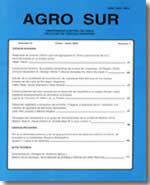Floristic and vegetational changes with different cattle managements in an andeptic palehumults soil (La Union, X Region, Chile)
Main Article Content
Abstract
Volcanic soils of the red clay type (andeptic palehumults) are abundant in the dry coastal zone of the Valdivia province (X Region, Chile). To the west of the city of La Union, in the rain shade area, these soils were originally covered with sclerophyllous forests of Boldo (Peumus boldus), with a deciduous canopy of Roble (Nothofagus obliqua) belonging to the plant association Nothofago-Perseetum linguae Boldetosum. After felling or burning the forest, soils were cultivated with cereals or legumes and subjected prairie management for raising either cattle or sheep. An ecological comparison between prairies after 30 years of management for both types of animal was conducted. A total of 34 vegetation censuses (17 for each type of management) were carried out using phyto-sociological methods. The flora of both prairies was found to contain few species; especially those where sheep had been maintained, which also appeared to be more degraded. Prairies managed with bovine developed a plant association Hyperico -Agrostidetum capillariae, which when degraded and abandoned can be invaded by Blackberry (Rubus constrictus). Sheep management conditioned the formation of other plant association, Airo- Agrostidetum capillariae, that can be invaded by Wild rose (Rosa canina) after abandonment Allochtonous flora was predominant in both type of prairies, but in that managed with sheep indigenous species were found, the prairie being floristically more homogeneous with abundance of annual herbs, indicating greater soil drought which is coincident with a greater penetration resistance of the soil.

